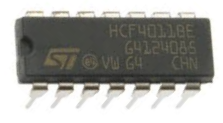What is an Active Low Device?

An active low device is a device that either outputs 0V when triggered on or that accepts 0V as input to turn on.
It really depends on whether the device is an input or an output device.
Active Low Input Device
Let's deal first with an input device.
A classic example is the NOR gate logic chip.
A NOR gate is an active low device.
This means that it only turns on an output when fed 0V, or an signal below 1/2 of the supply voltage (which would then be read as a logic 0 signal).
Only when both of the inputs fed into the NOR gate are at a logic LOW (0) will it turn on.
If any of the inputs of a NOR are a HIGH signal (1), then the NOR gate will not turn on, so the load connected to its output pin will not turn. Any input where the voltage is greater than half of the power supply to the NOR gate will be interpreted as a HIGH signal.
This is what is meant by an active low device.
Active Low Output Device
An example of a device that outputs a voltage instead of reads an input voltage like a logic gate is an infrared proximity switch sensor.
This is a sensor that normally outputs a HIGH signal (3.5V) on its signal line when no object is in front of it. When an object comes in front of it, it outputs a LOW signal (0V).
So when not triggered, it normally outputs a HIGH signal on its signal line. When triggered on by an object coming in front of it, it outputs a low signal on its signal line.
So it sends a LOW signal when triggered on. Therefore, it is an active LOW device.
Related Resources
How to Build a Light Detector Circuit with a NAND Gate Chip
How to Build a Night Light Circuit with a NAND Gate Chip
How to Build a NAND Gate Circuit Using a 4011 Chip